

|
Archive for the ‘Exercise Science’ Category
Sunday, September 7th, 2008

Tell me, what is it you plan to do with your one wild and precious life? — Mary Oliver
I definitely plan to finish the second half of the Colorado Trail. That is at the top of my “things I absolutely HAVE to do during my one wild and precious life” list. Hopefully I can finish it next summer as work and family responsibilities have put completion of our journey on hold for now. My son and I recently finished the first half of the CT — from Denver to a trailhead between Buena Vista and Salida. We backpacked close to 250 miles and trudged up (and also down) some 37,000 feet of elevation gain.
That’s a lot of ups and downs. In a variety of ways and for a variety of reasons. Our trek took us through four different wilderness areas and over several mountain ranges. In addition to a variety of terrain, we experienced all kinds of weather as well — including sun, rain, sleet, hail, and even snow. We also inadvertently timed our travel through the Mt. Massive Wilderness area during the Leadville 100 Mountain Bike Race and ended up having to spend the night at a hotel in Leadville (aaahhh, nothing like a warm shower and a soft bed). Lance Armstrong competed in the event, which is intense to say the least. It’s a 100 mile off-road mountain bike race with what is described as “steep climbs and serious descents.” No kidding! The start and finish is in the heart of the small mountain town of Leadville, CO (elevation 10,200 feet). Fifty miles out and back with a turnaround point at 12,600 feet makes this race pretty dang extreme. After 100 miles, Lance was second by less than 2 minutes! How does that happen? Two minutes after 100 miles of mountain bike racing? And there were hundreds of entrants.
There’s also a Leadville 100 Ultra Marathon which is billed as the “Race Across The Sky” and considered one of the toughest distance races on the planet. It was held the following weekend. Starting at 4 AM, with most of it on the Colorado Trail and the Continental Divide Trail, it’s a true high-altitude, hard-core distance race. To make it even more interesting, this year runners experienced rain, wind, lightning, marble-sized hail, and snow during their 100 mile marathon. Almost sixty percent of the entrants didn’t finish. They’ve been doing this race for 26 years now and they never cancel because of the weather. Hardy souls indeed.
But I digress…
We experienced some of the same weather during our journey, but at least we were in our sleeping bags and tents at 4 in the morning and we didn’t have to cover more than about 12 to 15 miles a day. Some longer days, some shorter days.
Spending that much time in the wilderness allows for hours and hours of time to think, reflect, figure things out, day-dream, re-figure things out, make up endings to stories, sing Johnny Cash songs, wonder what that noise was, think about food, learn to whistle, re-re-figure things out, and have long annoying conversations with yourself. And on it goes, day after day. No money to deal with, no bills to pay, no TV to watch, no phone to answer, no email to check, no newspaper to read, no gas to pump, no purse to dig through, no mirror to look into, no BlackBerry to obsess over (not that I have one). Going back to the basics is incredibly cleansing. I highly recommend it.
Now I’m in the midst of putting together my backpacking meal recipes, sport-specific nutrition information, dehydration tips, and instructions on how to prepare and pack your own food for the backcountry. Most prepackaged backpacking foods contain gluten or other allergens and most companies can’t guarantee that their food is gluten-free, even when there are no obvious gluten-containing ingredients. Most of those foods either use gluten as a filler or prepare their foods on equipment that also processes foods containing gluten. The last thing I want is to get sick while backpacking. No time to have stomach issues. Or achy joints. Or be overly tired. Or have trouble sleeping. Or have headaches.
Well, you get the idea. That’s why I felt it was important to make and prepare all my own food. That way I was able to balance my nutritional needs for exactly what I was doing — this means eating strategies for all-day energy, what to eat when you need a boost to make it up and over the pass, and how to adequately recover so you can start all over again the next day. I’m interested in sport-specific nutrition and how to maximize performance and stay healthy at the same time. I’m thinking a book is in my future. Wish me luck.
In the meantime, here’s a photo wrap-up of our trip, with a reader contest to top it off.
Next week I’ll get back to regular posting with nutrition tips, recipes, and whatever else comes to mind. Does anyone have a topic they’d like me to focus on? Something you might be confused about or interested in? Leave me a comment indicating what’s on your mind and I’ll pick one of the topics and write a specialized post on it.
Sugar? Omega 3s? Antioxidants? Caffeine? Coffee? Sports drinks? Boosting immunity? Strong bones? Wine?
Let me know.
  
Photo #1 — Melissa filtering water (a wilderness woman’s job is never done).
Photo #2 — Columbine, the Colorado state flower.
Photo #3 — Breckenridge Ski Area way in the distance.
  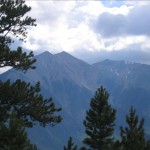
Photo #1 — I became obsessed with taking pictures of signs along the trail. Some were interesting, some informative, some just plain funny. These little “thumbnail” versions of my photos aren’t great, so I doubt you can see this very well, but it says, “Colorado Trail & Tennessee Pass” with an arrow one direction, then it says “Old Mine” with an arrow the other direction. Who knows where the old mine is as we had just come from that direction and never saw one. Hmmm?
Photo #2 — Very old CT sign, with an awe inspiring back-drop.
Photo #3 — Big mountains.
 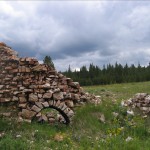 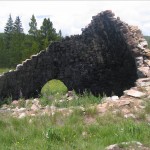
Does anyone know what this is? Keep in mind, this “find” was out in the middle of nowhere along the Colorado Trail. The first person who knows the answer gets a prize. Take a guess!
And don’t forget to get out there and enjoy your one wild and precious life!
In good health,
Melissa
Wednesday, August 13th, 2008

One-hundred and sixty miles down. Three-hundred and forty to go.
We’re one-third of the way through our trek of the Colorado Trail. Depending on what you read, the trail covers anywhere from 485 to 500 miles — from Denver to Durango — with a total elevation climb of 77,690 feet. As I said in the first post I did on the Colorado Trail, that’s a LOT of uphill. We’re now on a 200 mile section of the CT that shares the same footpath as the Continental Divide Trail, so we’re spending more and more time above 10,000 feet, often in alpine zones above timberline.
I’m cooking and dehydrating all our dinners and we’re eating well. And gluten-free, of course. In fact, I have chicken, quinoa noodle, and veggie soup in the dehydrator as I type. With chile con carne waiting in the wings.
Rather than ramble on about the trip, I’ll share some photos with you instead. I’m in a pinch for time, but when things slow down, I’ll get back to posting on a more regular basis. For now, here’s a preview of where I’m spending so much of my time lately. Although the days are long and tiring, there’s nothing more rejuvenating than spending time in the wilderness. No phones, no money, no traffic, no silly TV shows. I love it!
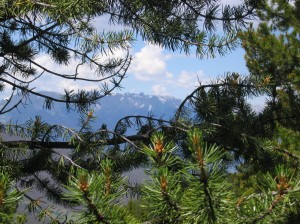
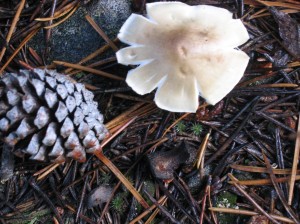


If that waterfall hadn’t been so dang cold, I would have taken a shower — with all my clothes on. They needed washing as much as I did. I won’t even mention how my hair looks after a week of backpacking, although bad hair days aren’t a big deal when all you see during the day is your hiking partner, a few marmots, and a couple of deer.
Onward . . .
Melissa
Sunday, June 22nd, 2008
This post will focus on sport-specific fuel for energy — gluten-free fuel no less. Balancing GF food sources for optimal physical performance is easier said than done. In this case, eating and snacking for sustained energy while hiking and backpacking in Colorado’s high country. Fueling up for “peak” performance (bad pun, I know).
But before I launch off on fats, carbs, and protein, I’d like to thank Mike and Adam for giving my blog a spring cleaning and a sweet make-over. Nice job, guys — I love it! As you can see, it’s much more organized, offering an easier way to track down topics of interest.
Onward…
I took this photo about a quarter of a mile into a hike up Mt. Parnassus, a 13,579 foot peak in Colorado’s Front Range. Last week! Yes, it was snowing in mid-June and it came down harder the higher we went. June appears to be the new February, at least around these parts. The point is, be prepared for anything if you’re hiking in the Rocky Mountains. That goes for clothes, snowshoes, ice axes, and food. Well, you might be able to skip the ice axe, depending on where you’re headed. But there’s still a LOT of snow up there this year!
There’s a possibility that I may be taking a long backpack trip this summer, so I’ve been busy dehydrating and preparing my own food since most ready-made backpacking meals are laden with gluten. Yes, it’s everywhere, it’s everywhere! Plus, a lot of the processed stuff isn’t all that nutritious or tasty. I need both. I’m way past the age where I can get by lugging a heavy backpack and plodding along above timberline with a package of Ramen noodles for fuel. Even if they were gluten-free. I need more help than that at this point in my life. No room for error. Not much, anyway.
So, here’s what I need — consistent, high-quality nourishment for long days of hiking; several high-octane boosts when I start wandering up above 12,000 feet; and plenty of recovery fuel. Oh, and lots of antioxidants and essential fatty acids to take care of my very stressed out cells. Think fatigued muscles, sore feet, high-altitude sunburn (hard to avoid, even with sunscreen), strains, scrapes, bruises, and electrolyte imbalances. Sound like fun?
Actually, I can’t think of anything I’d rather be doing on a beautiful summer day than exploring the wilderness, climbing peaks, and traveling in the backcountry. I’ve had a long-standing love affair with nature. But in order to stay healthy, carry a loaded backpack, and do so efficiently and injury-free, I need to eat right and sleep well. That’s sometimes hard to do at 10,000 feet.
I expect a lot from my food. Here’s how and why.
Proper nutrition forms the foundation for physical activity — whether it’s hiking, walking, or playing tennis. Food provides the chemical energy, or fuel, to do mechanical work. Nutrients also provide the essential elements for the repair and maintenance of the body and the synthesis of new tissue, which is very important when you’re running yourself into the ground on a long backpacking trip. Carbohydrates (glucose), protein, and fats are biological fuel. If you want to enjoy your activity, improve your performance, and recover more rapidly, proper fueling is essential.
Glycogen is the body’s version of premium fuel. It’s the principle storage form of glucose (sugar) and is stored in the liver and muscles. Carbohydrates provide the body with glucose, which can be stored as glycogen. Topped-off glycogen levels will increase the amount of time you can hike and will also improve your performance. Or at least prevent stumbling head-on into the “wall.” Or falling off a log into a raging stream. If you don’t refuel while exercising, once the original glycogen stores are depleted, fatigue sets in. Rapidly.
Eating carbs during intense activity will help reserve glycogen stores and provide blood sugar for your brain and muscles to use. Not only do you want to maintain your muscle strength, you also want to think clearly and make good decisions. The higher you go, the harder that gets. Eating the right nutrients and replenishing glycogen stores soon after a hard day in the mountains helps facilitate recovery, helps you sleep better (on lumpy ground while listening for bears) and gets you ready for the next day. Believe me, you’ll be happy you ate well the night before when you roll over in your sleeping bag at 6 AM and have to work the kinks out just to climb out of your tent.
What you eat prior to hitting the trail impacts how your day starts. Regardless of whether you’re hiking a level and well-traveled trail or climbing a mountain, you’ll need to focus on maintaining your energy. And that means doing it day after day if you’re backpacking. Here’s a simplified version of how specific foods are broken down, absorbed, and used by the body. Simple sugars are absorbed fastest, next comes low-fiber complex carbs, then high-fiber complex carbs. Proteins and fats take longer to break down and assimilate, so ideally, you want a mix of these fuel sources. Backpacking requires all aspects of physical activity. Plus, you’re asking your body to sustain the intensity all day. Now add in altitude, hydration issues, and marginal weather, and your fuel needs are major.
Here are some basic principles for maintaining energy and fueling your backcountry diet.
Complex carbs
High-fiber, complex carbs will help you log long hours on the trail. They’re digested more slowly and help maintain consistent blood sugar levels so you don’t crash when you need to pick up the pace if threatening clouds are moving in. Or, you think something is following you in the woods. Brown rice, quinoa, gluten-free pasta, oatmeal, buckwheat pancakes — foods like that should be at least half your trail diet.
Simple sugars
Say you’ve been plodding along at a moderate intensity for 3 or 4 miles. You check your map and suddenly realize you have a substantial climb ahead, what do you do? Other than break down and sob. Your first thought is to stomp your feet, but you quickly realize your boots are too d**n heavy to bother. You need a quick fix and that comes in the form of simple sugars; something that is digested and sent out to your working muscles ASAP. The quicker, the better. Before you cry as your brain slowly translates how closely spaced the contour lines are on your map.
I’m a nutritionist and eat a fairly good diet most of the time. I rarely eat packaged foods, I stay away from processed sugar, and avoid junk foods at all costs. Here is where all rules go out the window. Now is when I grab the power shot or start downing jelly beans. I’d drink cheap maple syrup straight from a BPA-laced plastic bottle at this point if I could. Thank goodness for the fine folks at Clif Bar for coming up with a more manageable and packable version of quick energy. My current favorites are Clif’s Vanilla or Mocha Energy Gels. I also like Whole Foods organic jelly beans. That’s a great thing to keep at your fingertips while hiking (stick a baggy full in your pocket). Pure sugar. Aaahhhh, I love it, especially when facing down a 2,000 foot elevation gain in a short distance. Other good choices are dried fruits, trail mix, chocolate chips, or raisins.
Fat
Fats have been given a bad name, rightly and wrongly so (as I’ve said before). We need good fats for all-day, steady-state energy production. Especially when hiking day after day. Fats also help keep your engine warm on cold nights in the mountains. Healthy fats like nuts are an important part of a backpacker’s diet — and they’re easy to travel with. Salmon jerky, which is high in good fat and protein, is another good food to munch on while hiking. Even sausage and cheese make good trail food. An extended backpacking trip is not the time to go on a low-fat diet, just make sure your choices don’t contain transfats or hydrogenated fats.
Protein
Protein helps repair the muscles and connective tissue you break down during long hikes. Beef jerky, brown rice pasta, quinoa, and teff make great building blocks for muscle and tissue repair. Backpacking stresses your muscles day after day, adequate protein intake will help mitigate that and keep you strong and healthy.
Now go out and explore!
Next time I’ll focus on antioxidants, essentail fatty acids, and electrolytes. I’ll also include a recipe for gluten-free power bars.
In good health,
Melissa
Friday, September 21st, 2007
This post will be the art of aging, part 1. Part 2 will follow at a later date. I need to get older to do part 2.
The good, the bad, and the ugly truth about aging and how to avoid acting your age as you rack up those birthdays.
When we hear the word aging, we automatically think of older people, but the truth is, we start aging at birth when we choke, sputter, and take our first screeching breath announcing our arrival to the world. Functional and structural changes occur in the body throughout life, but once maturity is reached at age 20 to 25 years, growth stops and by around age 30, age-related changes can become noticeable. Can become noticeable, but many of these changes aren’t inevitable. Let’s start with the cold, hard facts (the bad and the ugly) . . .
Changes in body composition occur. Lean muscle tissue decreases and body fat increases. Research indicates that beginning at age 30 we can expect a loss of about a half-pound of muscle tissue per year. As this ratio changes, metabolic rate falls.
Decreases in strength and power occur. With the loss of lean muscle tissue comes a decline in the functional structure of the muscle which translates to less strength, less power, and a longer response time.
Flexibility is reduced. Tendons, ligaments, and cartilage become stiffer and more rigid with age and more prone to injury.
Cardiac function is reduced. Heart muscle strength begins to decline as we age, and with it, pumping power. Arteriosclerosis (hardening of the arteries) and increases in blood pressure also make it difficult for the heart to function properly.
Aerobic capacity declines. Simply put, this means it becomes more difficult for the heart and circulatory system to transport the oxygen the body needs to exercise.
Yada, yada, yada. Okay, we get it. So, now who says we have to follow those rules? Well, the truth is, we don’t.
Now the good news. Although a reduction in muscle mass and an increase in fat tissue is the norm with aging, it’s not inevitable. It takes some effort, but with regular exercise, some type of strength training, yoga, and by controlling energy intake (it’s that calories in/calories out thing) and eating the right kinds of foods, older athletes can maintain the same body-fat ratios as younger athletes. Studies show that people who engage in resistance training can increase their lean body mass component and decrease body fat. It’s even possible to gain muscle mass with increasing age. I’m not all that into the gym scene, but a good vinyasa yoga class with some arm balances and inversions can accomplish the same thing. It really doesn’t matter, just get up and move. Dance, walk the dog, do cartwheels, play tennis, stay active.
Along with maintaining lean muscle tissue, strength training also increases muscular strength and power, no matter what your age. In fact, the results of one study showed that untrained men ages 60 to 72 were able to increase quadriceps strength by over 100 percent and hamstring strength by over 200 percent — all in just 12 weeks of resistance training. Strength training has also been indicated to help protect against osteoporosis. Good, good. Do pushups. Use jugs of laundry detergent for weights, you don’t have to make this complicated.
Flexibility can be maintained or increased at any time of life. Being aware of proper hydration and participating in a flexibility program can help prevent injuries, and protect joints, muscles, and connective tissue. Yoga and Tai Chi are great choices no matter what your age. An added benefit is increased balance, grace, and coordination. Yoga, yoga, yoga. That’s my mantra. And I’m a true believer that balance is a great indicator of overall health. It’s one of those things you can easily work on and increase whether you’re 10, 20, or 100 years old. It doesn’t matter, you can enhance balance at any age. (I plan to do a complete post on balance one of these days, that’s how important I believe it is to optimal well-being.)
Cardiac health can be enhanced and functional losses reduced with proper training and nutrition as well. Many of the cardiovascular changes that take place as we age are the result of lack of use and poor lifestyle choices rather than aging. Regular aerobic exercise, a healthy diet, eliminating stress, and getting quality sleep (that can be a tough one), can minimize or even reverse cardiovascular declines. Although aerobic capacity tends to decline with age, this doesn’t have to be the norm.
Make up your own rules! What you eat, think, and do will reflect in how you age. Emotions and attitudes about aging are just as important as physical activity. And don’t forget the sense of humor!
In good health!
Melissa
Disclaimer: All material on this website is provided for informational and educational use only and
should not be used for diagnostic purposes. Consult with your physician regarding any health or medical concerns you may have.
|
|
|




















